Introduction
Giving birth is a life-changing experience that comes with many physical and emotional changes. It can also take a toll on your body. To help you recover from childbirth, many mothers turn to postpartum baths as a way to rejuvenate and relax. In this article, we’ll explore the benefits of taking a postpartum bath, as well as any potential risks involved.

Exploring the Benefits of Bathing After Childbirth
Bathing after childbirth has been around for centuries, and today it remains one of the most popular postpartum rituals. Taking a postpartum bath has both physical and psychological benefits, and can be a great way to pamper yourself after the stressful process of giving birth. Here are some of the benefits of bathing after childbirth:
Improved Circulation
A warm bath can help improve circulation in the body, which is especially important for postpartum recovery. Improved circulation helps reduce pain and swelling, and can also aid in healing any tears or incisions made during delivery.
Reduced Stress and Anxiety
The stress of childbirth can take an emotional toll on new mothers. Taking a hot bath can help reduce stress and anxiety, allowing you to relax and unwind. Warm water can also have a calming effect on the mind and body.
Relief from Aches and Pains
Postpartum aches and pains can make it difficult to move around or even get comfortable. Soaking in a warm bath can help relieve soreness and discomfort, making it easier to get back to your regular routine.
Taking a Postpartum Bath: Is it Safe?
While there are many benefits to taking a postpartum bath, there are also potential risks that you should be aware of. Here are some things to keep in mind when considering a postpartum bath:
Risks Involved with Taking a Postpartum Bath
The most common risk associated with taking a postpartum bath is infection. The vagina and perineum are still healing after childbirth, and soaking in a bath may increase your risk of infection. Additionally, if you’ve had a Cesarean section, you should wait until your incision has healed before taking a bath.
When Should You Avoid Taking a Postpartum Bath?
If you have any signs of infection, such as fever, chills, or foul-smelling vaginal discharge, you should avoid taking a postpartum bath. Additionally, if you’re experiencing heavy bleeding, you should wait until it has slowed down before taking a bath.

How to Prepare for a Postpartum Bath
If you decide to take a postpartum bath, there are a few things you can do to prepare. Here are some tips for preparing for a postpartum bath:
Gathering Supplies
Before taking a postpartum bath, gather all the supplies you’ll need. This includes a clean bathtub and a mild soap, as well as any essential oils or herbs you plan to add to the water. Additionally, it’s a good idea to have a washcloth and towel nearby, as well as something to eat and drink while you’re in the bath.
Taking Care of Wounds or C-section Incisions
If you’ve had a tear or episiotomy, or if you’ve had a Cesarean section, it’s important to take extra precautions when taking a postpartum bath. Make sure your wound is clean and dry before getting in the bath, and avoid scrubbing or rubbing the area. Additionally, it’s a good idea to use a waterproof bandage or dressing over any wounds or incisions.
Home Remedies for Postpartum Healing in the Bath
There are many home remedies you can use to aid in postpartum healing while taking a bath. Here are some of the most popular remedies:
Herbal Baths
Herbal baths are a great way to soothe sore muscles and speed up healing. Some herbs that are known to have healing properties include chamomile, lavender, calendula, and comfrey. To make an herbal bath, simply steep 1-2 handfuls of herbs in boiling water for 15 minutes, then strain out the herbs and add the liquid to your bath water.
Epsom Salt Baths
Epsom salt baths are another great way to relieve soreness and promote healing. Epsom salt is rich in magnesium, which can help reduce inflammation and muscle tension. To make an Epsom salt bath, simply add 2-3 cups of Epsom salt to warm bath water and soak for 20 minutes.

Tips for Enjoying a Relaxing Postpartum Bath
Once you’ve prepared for your postpartum bath, there are a few more things you can do to ensure a relaxing experience. Here are some tips for enjoying a postpartum bath:
Adding Essential Oils to the Water
Essential oils are a great way to add some extra relaxation to your postpartum bath. Lavender oil is especially helpful for reducing stress and promoting restful sleep. Simply add a few drops of essential oil to your bath water and enjoy the calming aroma.
Keeping the Temperature Comfortable
It’s important to keep the temperature of your bath water comfortable. Too hot of water can dehydrate the skin and leave you feeling drained. Aim for a warm, not hot, bath and make sure to stay hydrated throughout your soak.
Setting Aside Time for Yourself
Postpartum recovery can be overwhelming, and it’s easy to forget about taking care of yourself. Set aside some time each day for a postpartum bath and use it as an opportunity to relax and recharge.
Conclusion
Taking a postpartum bath can be a great way to promote healing, reduce stress, and just take some time for yourself. While there are some risks involved, a postpartum bath can be a safe and beneficial way to start your postpartum recovery. By following the tips outlined in this article, you can enjoy a relaxing postpartum bath and begin your journey of motherhood with a little extra self-care.


